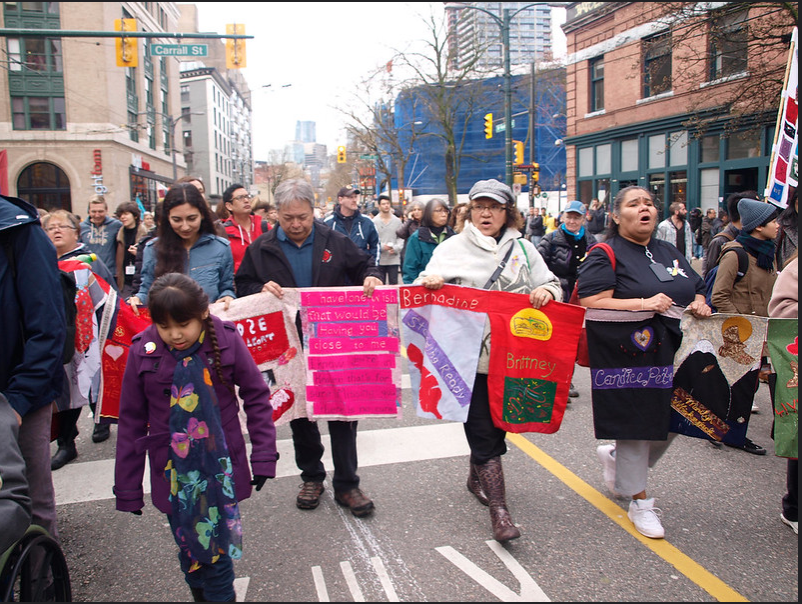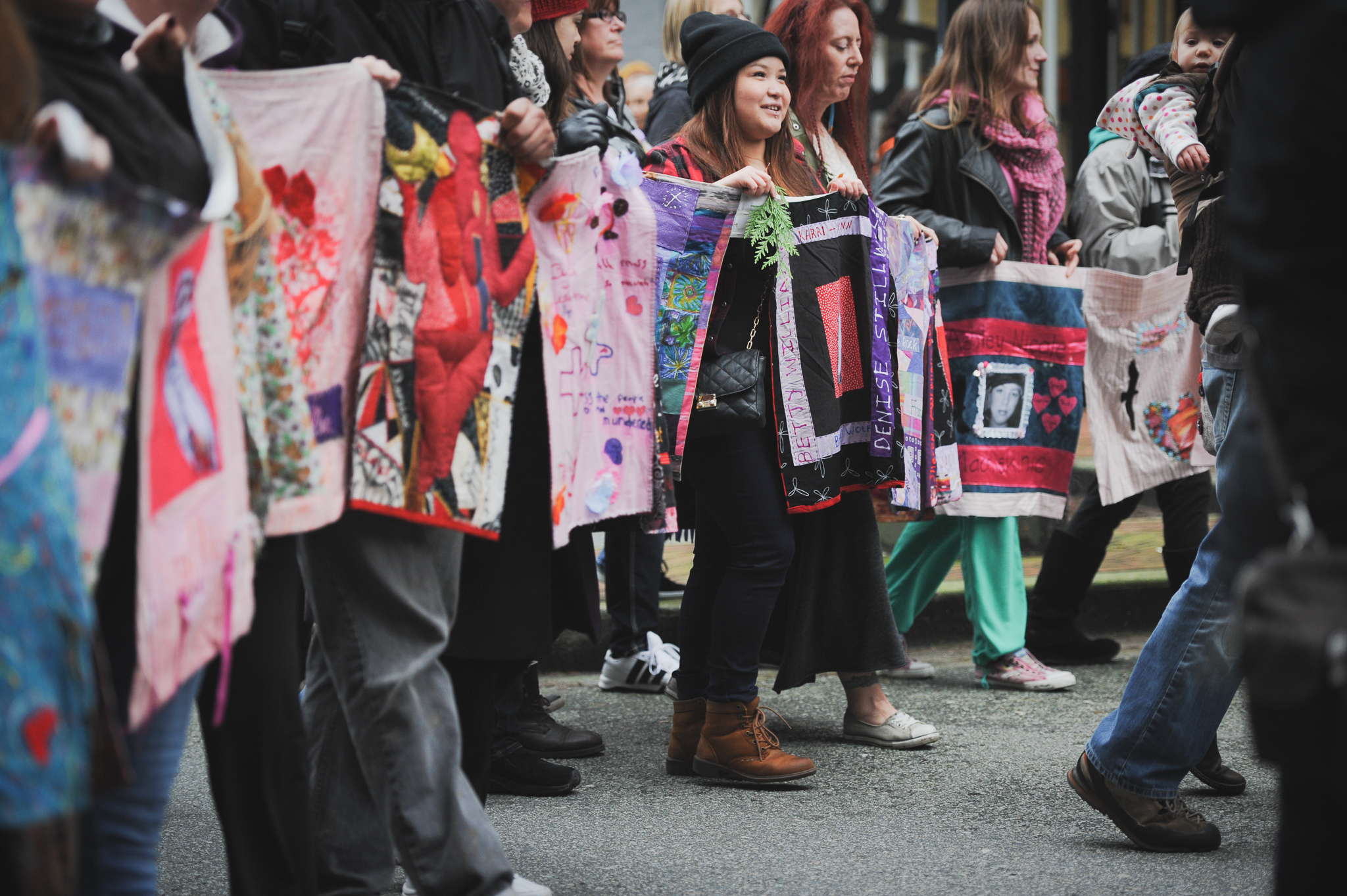The Women’s Memorial March (WMM) is held every year on 14 February, Valentine’s Day, in cities across Canada and the United States. The WMM started in 1992 in Vancouver, BC, following the murder of Indigenous woman Cheryl Ann Joe. The first Women’s Memorial March began as a small memorial for Joe, but grew to become an annual march to honour all missing and murdered Indigenous women and girls. The Vancouver march draws thousands of people, while women’s memorial marches have spread to more than 20 cities across Canada and the United States.

Women’s Memorial March, Vancouver, 2015.
Origins of the March
Cheryl Ann Joe was murdered on 20 January 1992, her body dumped in a parking lot near a warehouse loading dock on Powell Street in Vancouver’s Downtown Eastside (DTES). This area is known for heavy drug use, high crime rates and sex work. Weeks later, on 14 February 1992, Valentine’s Day, several dozen people, including Cheryl Ann Joe’s mother, Linda, met in the same parking lot where Cheryl Ann Joe’s body was found.
Linda Joe and DTES women decided to host an annual grassroots event to “express compassion, community and caring for all women in Vancouver’s Downtown Eastside.” The Women’s Memorial March in Vancouver begins every year in that neighbourhood, led and organized by women in that area. Thousands of marchers fill the streets and stopfor a moment of silence near places where women have been murdered. The event includes speeches by local activists, a traditional Indigenous healing circle at Oppenheimer Park and a community feast.
The focus of the Women’s Memorial March has since expanded to honour the lives of murdered and missing Indigenous women and girls across Canada. Each year, Vancouver’s march organizers publish a booklet that lists the names of women and girls who have died, gone missing from, or been murdered in the Downtown Eastside. In 2019 alone, there were 75 new names. Many march participants have lost a family member or friend in the DTES. There are only five banners carried at the march, but many marchers also carry signs with the name and/or image of their murdered or missing loved one.
In the Vancouver march, high school students from Surrey, British Columbia, create and carry a banner in solidarity while others video the event to help with documentation. University students support organizers.
The Vancouver march receives no provincial government funding. The city’s police department waives the cost of an event permit, traffic control and security presence.
The March’s Catalyst
Murder victim Cheryl Ann Joe, a 26-year-old single mother of three small boys, was a member of the shíshálh Nation (Sechelt) on British Columbia’s Sunshine Coast (see Northern Coast Salish). She had lived there before challenges with housing, finances and alcohol led her to work in the sex trade in Vancouver’s Downtown Eastside. She was trying to earn money to go to Alberta to visit two of her children who were living with their dad.
Joe had planned to be a police officer to help protect the city’s vulnerable. “Every time she was out on the street, she encouraged the younger women [in the sex trade] to get off the street and find a better way of life,” says her cousin Melodie Casella.
Murder Conviction
Within hours of the discovery of Cheryl Ann Joe’s body, detectives had suspect Brian Allender, 36, in custody and charged him with first-degree murder.In 1993, a jury convicted Allender of first-degree murder and he was sentenced to life in prison.
DID YOU KNOW?
Since the first Women’s Memorial March, more than 970 names have been added to the list of women who have gone missing or been murdered in Vancouver’s Downtown Eastside (DTES). These include victims of serial killer Robert Pickton, convicted in 2007 of the second-degree murders of six women. Although he was charged with the deaths of 20 more women, many from the DTES, the Crown stayed these charges in 2010. Pickton was sentenced to life in prison with no possibility of parole for 25 years.
Growth and Popular Response
According to organizers, the Vancouver Women’s Memorial March draws up to 7,000 people and remains the largest of its kind in the country.
Marches have expanded to other British Columbia cities (Victoria, Nanaimo, Courtenay, Nelson, Kelowna, Merritt, Penticton, Grand Forks and Prince George) and across Canada. Women’s memorial marches now take place in Alberta (Edmonton and Calgary), Saskatchewan (Saskatoon), Manitoba (Winnipeg), several places in Ontario (Toronto, Ottawa, Kenora, Sault Ste. Marie, Thunder Bay, Six Nations of the Grand River, Mississaugas of the Credit First Nation, London), Quebec (Montreal) and Newfoundland (St. John’s). They are also held in the United States in Denver (Colorado), Fargo (North Dakota) and Minneapolis (Minnesota).
Overall, between 40,000 and 50,000 attend a women’s memorial march in Canada each year.
Impact
Indigenous women continue to disappear in Vancouver’s DTES. According to the Women’s Memorial March website, “Indigenous women disproportionately continue to go missing or be murdered with minimal action to address these tragedies.”
“This is a healing ceremony for all,” said Viviane Rose Sandy, a member of the Shushwap Nation, at Vancouver’s 2019 march. “We’re marching, but we’re in circle — to us this is a sacred circle.”
“I get really emotional every time this [march] takes place,” said Carol Martin, one of the city’s march organizers. “Our First Nations women deal with a lot of systemic barriers in life.” She stated that non-Indigenous Canadians see First Nations women through a stereotypical lens, citing “systemic barriers” and racism. “Where can I walk as a First Nations woman that allows me to be free in who I am? All they see is labels. All they see is stereotypes.”
Cheryl Ann Joe’s aunt Gertie Pierre and Pierre’s daughter Melodie Casella, both social workers, spent months travelling across Canada to support families testifying at the hearings of the National Inquiry into Missing and Murdered Indigenous Women and Girls (MMIWG).
Pierre family members participated in the initial meetings with provincial, territorial and federal ministers when the national inquiry was being formed. In February 2016, they also took part in the second national roundtable on the inquiry in Winnipeg. Pierre and Casella provided testimony regarding the trauma of Joe’s murder in April 2018 at the MMIWG’s Vancouver hearings.
Significance
The Women’s Memorial March draws public attention to the impact of systemic violence against Indigenous women and girls and the traumatic effect on their families following their murders or unsolved disappearance. Besides providing a powerful vehicle for community mourning and healing, it has focused public demand for more sensitivity, services and collaboration from the National Inquiry into Missing and Murdered Indigenous Women and Girls regarding the impact of trauma.

 Share on Facebook
Share on Facebook Share on X
Share on X Share by Email
Share by Email Share on Google Classroom
Share on Google Classroom










